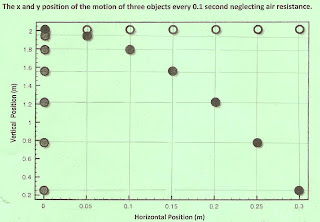Ohhh yeah. Time to do some work with throwing stuff. That's the best science there is.
The basics of projectile motion would be to learn about the x and y vector components of the projectile. Remember vectors? From a few blogs ago? Yeah those things.
Here's a diagram of a type one projectile motion, which is a falling object:
We first need to remember that Vx is always constant, so there is no acceleration. Or at least in this unit so far. In real life, there would be stuff like air resistance changing the Vx, but we won't go there yet.
Vy is affected by gravity from V1y = 0, and therefore Ay would be gravity. Gravity is 9.8 m/s^2, unless stated otherwise. You could be throwing a ball on the moon or something. I don't know what astronauts like to do in their spare time but ok. We should also remember, time is equal to both Vx and Vy. Distance of y would be the height of whatever it's falling from, and Dx would be VxT. That covers about the basics of the falling object.
Now let's take a look at the other type of projectile motion:
Vx is still constant in this case, again at least until up to this point of the unit. So Ax is still zero as well. What's different is that this time, we might have to find the Vx using the angle and initial velocity given, using the SOHCAHTOA thing again. This might be switched and we might have to find the angle using Vx, etc. Vy is effected by gravity again, but this time, gravity has a negative value of -9.8 m/s^2. This is because this time, there is a negative and positive direction of y, so gravity's direction needs to be specified or the numbers will be wrong. Again, we can find Vy using SOHCAHTOA like Vx. Also, in this case Dy = 0, since there has been no vertical displacement. At the highest point of the motion, represented by H, Vy = 0. The time is known as hang time in this situation, which we calculate by using one of the Big 5 equations, d = V1t + 1/2(gt^2).
There are actually two more types of motions, where the ball actually lands on a higher or lower ground from the beginning in the second type of projectile motion. In these cases, they would have a positive or negative value of Dy.


No comments:
Post a Comment